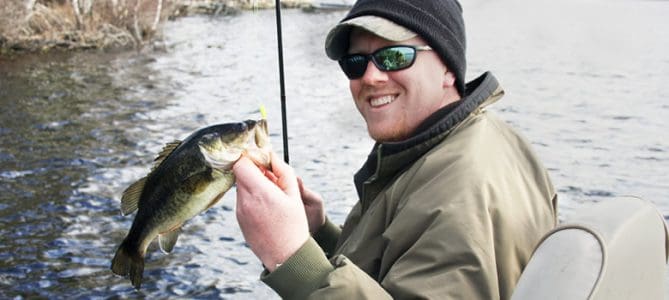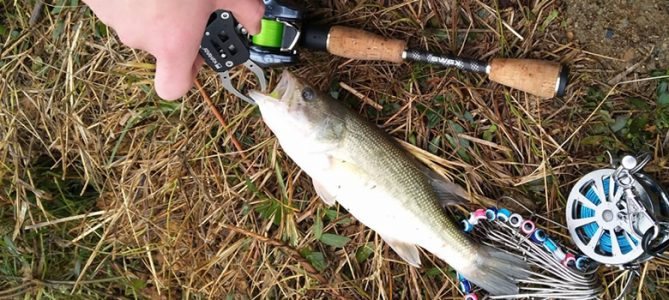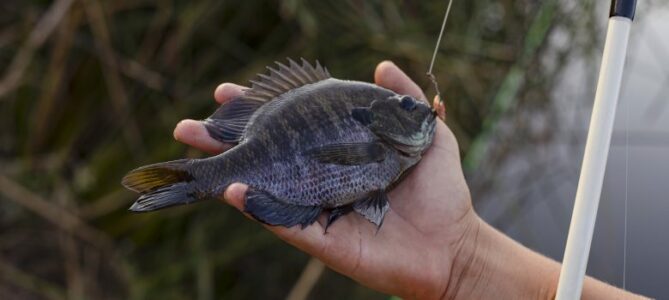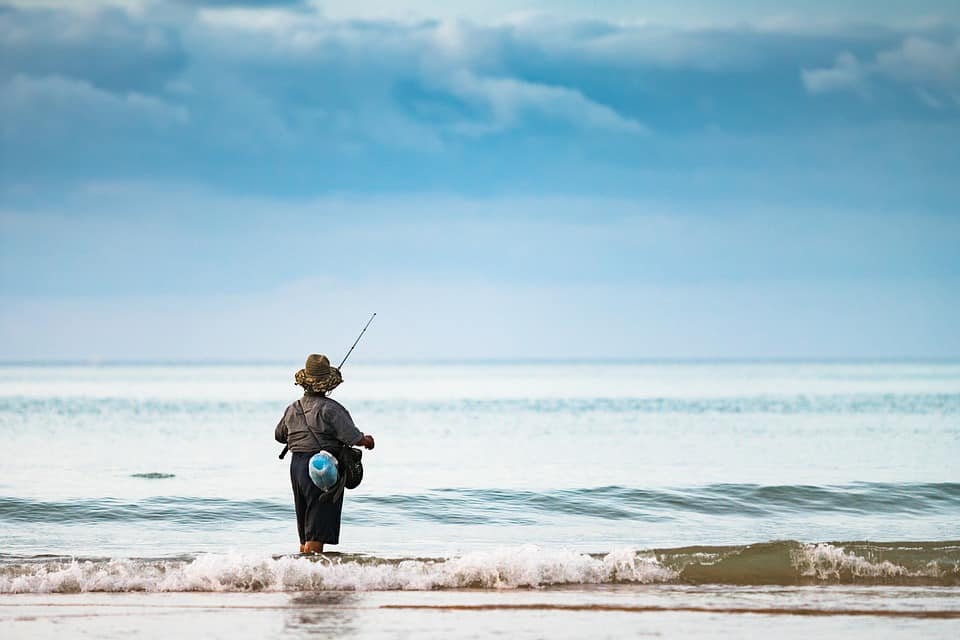If you buy via a link on this page, we may receive a commission, at no extra cost to you.Learn more
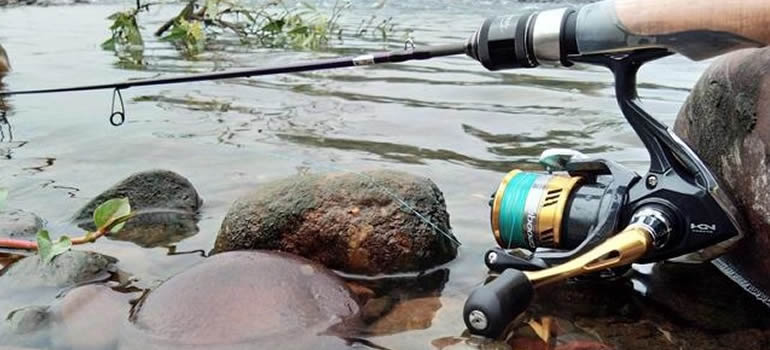
If there’s one thing that is on every fisherman’s bucket list it’s fishing for trout. Trout are fun, delicious creatures that come in a variety of shapes, sizes, and colors, which makes catching them a bit more difficult. Without knowing the proper way to rig your fishing pole, you might never get your hands on one of these wonderful species of fish.
How do you rig a fishing pole for trout? While the equipment, lure, and bait are imperative to complete a proper rig, the actual way to rig a fishing pole is done by doing the following:
- Tie the hook to the end of the fishing line.
- Insert a line at one end of the split, reeling to the opposite end.
- Attach the bobber near the hook.
Just because reeling in a trout is a bit more difficult than other fish doesn’t mean it’s impossible. With the right techniques, correct fishing rig, and desirable bait and lures, you too can become a trout fishing genius.
What is a Trout?
A lot of people know what certain trout look like and how they taste, but a lot of people don’t know what trout actually is. In fact, trout is simply a generic name used to describe a number of different freshwater fish species found in rivers, lakes, and sometimes the ocean.
The best way to describe trout is to compare them to salmon. They are more than likely around the same size as most salmon, and the large variety makes them common to the salmon. In fact, they are so much alike, they’re said to be a close relative of the Salmon family.
Where do they live?
One interesting fact about the freshwater species of fish trout is that some can actually switch back and forth between freshwater and saltwater. This is ultimately true for a variety of species, but the Rainbow Trout is certainly the most notable fish. He can switch from the sea to freshwater like rivers and lakes in no time.
Trouts can be found in a wide range of environments, and you can tell what type of trout they are by their colors as well as patterns. Trout ‘camouflage’ themselves depending on their environment, and can even change their colors before moving to their desired destination.
There’s a wide number of trout species found in the waters around the world. It can be incredibly challenging to name the specific breeds, especially if they are one of the ‘rarer’ trouts. However, there’s plenty of trout species that are in high population and can be easier caught than the rare species.
The simplest way to define the trout species is:
- There are exactly three ‘main’ species of trout to make distinguishing easier.
- There are three main species include the Brown, Rainbow, and Brook trout.
- Rainbow trout can also be known as steelheads in some areas, where they reside in the ocean until they spawn into a freshwater environment.
- Rainbow trouts are distinguished by a trademark silvery hue. This silver mark is also found commonly on salmon. Rainbow trout are the most popular trout species caught by anglers.
The Best Places to Find Trout
It’s true that trout can easily move from saltwater to freshwater without batting an eye. They are easily found in all types of water, including rivers, lakes, and creeks. However, the favorite waters for trout seem to be moving bodies of water with colder water temperatures.
Other Locations
- Stocked Lakes
Trout are also commonly found inside of stocked lakes. This makes it easy for the fisherman who is looking specifically to capture trout. They can find a stocked lake nearby and easily get their hands on trouts, sometimes multiple species of them.
- In the Ocean
Trout who have grown to larger sizes will typically move into the ocean. They are in need of smaller fish to munch on, and ravaging the salmon around them in the lake simply will not do.
- In the Forest
Another likely place to find trout is in remote locations, especially the forest. Trout are eaten by all types of wild animals found in the woods, including bears, raccoons, and more. For that reason, you’re likely to find large quantities of this fish who are sustaining large animals around them.
To put it simply, you can find trout just about anywhere. Since they are so adaptable to different waters, you’re likely to throw your line in the water and come out with some species of trout. This is why they are one of the most sought after species by fishermen.
Setting Up the Rig for Fishing Trout
One of the most important steps of trout fishing is setting up the proper rig. The rig is just a term used by fishermen to describe how they arrange their equipment for the best outcome. The right rig can lead to plenty of trout catching and can be done using your rod, done by hand, or used on a boat.
While there are a few different ways to set up a trout rig, this is by far a tried and true method that is used by a majority of fishermen:
Equipment Needed for the Trout Rig
- First and foremost you’re going to need a fishing rod and reel. Many amateur fishermen will have this imperative piece of equipment already, but if you’re brand new to the fishing world you can pick up a good rod and reel for less than $100.
Product to Consider: The Tailored Tackle Universal Multispecies Rod and Reel Combo is a great option for beginners and novice fishermen alike. For only $65 you can get a reel that allows for utmost sensitivity while fishing with enough strength to catch species from small to large. The best news is that this particular line is designed for trout-perfect!
- You can’t catch fish without a fishing line, and that’s why it’s next on the list. Now, more often than not your fishing rod and reel will come complete with fishing line. However, if it doesn’t, you will want a 5 to 10 lb fishing line spooled into your fishing reel.
Product to Consider: The HERCULES Cost-Effective Super Strong 4 Strands Braided Fishing Line is a superior choice. With zero stretch and durable material, you can rest assured any catch of trout big or small is no match for your line. Best yet, it’s only $5. You can’t go wrong.
- The right hooks are an essential piece of the puzzle when it comes to trout fishing. These hooks are exactly what’s going to nail that trout to bring him home, so having the right size is key to success.It’s recommended to choose a hook anywhere between 4 and 12.
Product to Consider: Easy Catch ® 50 Pack Fishing Assist Hooks is an excellent option if you’re looking for a lot of hooks that are sturdy and reliable, but don’t cost too much. This batch comes with 50 stainless steel hooks that are sharp enough to capture trout with ease. There are several different options available, but remember to choose between 4 and 12 for best results.
- A good bobber may be useful. While not critical to trout fishing, the bobber, also known as ‘float’ will let you know when the fish has taken the bait. This can truly help your trout fishing game! Just make sure it isn’t too small so the bait sinks it.
Product to Consider: 10pcs-50pcs/lot Hard ABS Fishing Bobbers Set are easy to use snap-on bobbers that are about 1-2 inches in diameter, making them a great option for perfect trout fishing. With sets ranging from 10 to 50 pieces, you can have plenty of bobbers on hand for all of your fishing needs.
- Sinkers are also important. Sinkers are important for keeping your bait down in the water, but it shouldn’t be excessively heavy that it draws the bobber underneath the water. Be careful when choosing the right sinker!
Product to Consider: Bullet Weights Disc Fishing Sinker is extremely easy to use, and provide just enough weight to keep the weight down without bothering the bobber. There are a different size and weight selections, so find the one that matches with your bobber.
- Last but not least, the right bait needs to be used. Worms can be a simple solution for trout bait, but you can also use a variety of trout-favorites including insects, fish eggs, minnows, and crawfish.
Product to Consider: For a perfection option for luring trout, consider the Trout Magnet Neon Kit. The design of these jigs is different than other options available on the market, making them the ideal choice. The jigs lure trout and ensnare them with ease. It’s definitely a piece of equipment you want on your side while trout fishing.
It may seem like a lot of different accessories needed, but once everything comes together you will realize it’s a lot simpler than it seems. With all of your essential trout fishing equipment in place, you can put together a proper rig that’s excellent for fishing all species of trout.
Setting Up the Rig: Step by Step Guide
Once you have all of the right equipment for trout fishing you will need to know how to set up the rig for proper usage. We’re going to break it down step by step so you can spend less time dealing with your fishing equipment and more time out on the open waters:
- You will begin by tying the hook to the end of the fishing line. While you can settle for a simple tied knot, there are other options that can make your experience more productive. Here you can find 10 great ways to tie a hook to the end of your fishing line.
- Once your hook is properly knotted onto the end of the fishing line, you will want to insert a line starting at one end of the split, reeling it all the way through to the other side. You should be careful to ensure that the distance of the line is at least 10 to 15 centimeters above the hook for best results.
- The last step in setting up your trout rig is to attach the bobber. The bobber will be placed directly at the tip of the fishing line near the hook. Always make sure that your fishing line is running completely around the bobber and should be ‘anchored’ by the hooks on the line.
As you can see, putting together a great tour fishing rig is easier than you think. As long as you have the proper equipment set up the right way you can quickly be on your way to catching trout of all shapes and sizes.
Lure and Bait: The Must-Haves
Just as it is important to set up your rig the right way, it’s just as important to know what to use as a lure and bait. The lure and bait will be the main components leading the fish to your hook, which ultimately catches the trout. So what’s best?
The Top 8 Lures for Trout Fishing
The lure is exactly how it sounds: it will be the product that is used to lure the trout to your bait, leaving you with an incredible catch. Knowing what lures are best for trout fishing can truly be a game-changer. We’ve ranked the top 8 lures used for trout fishing:
- The Panther Martin. This is the tried and true method for many fishermen who enjoy spinners for lures and is best used in streams and rivers of smaller sizes. The Panther Martin is a tad bit heavier than other lures, but trout seem to love them. Many fishermen claim to have the best success with this spinner.
- Trout worms. Worms are always going to be a top pick when fishing because fish just downright love them; and the trout species are no exception. You can easily find and use your own worms dug right out of the ground, but many people opt for fake worms that are either scented or unscented.
- Product to Consider: Berkley Gulp! Floating Trout Worms are a successful option. With a lifelike presentation, this 20 pack of essential trout worms are guaranteed to bring more trout to your bait in no time. Durable and trusted with high-quality materials, you can rest assured that this is the next best thing compared to real worms.
- Trout jigs. Although understated, trout jigs are a wonderful option when it comes to catching trout. Jigs can be made from a variety of materials and can even be homemade. From feathers to fur, jigs offer a wide selection of options that any trout fisherman can find handy.
- Product to Consider: JSHANMEI 20 Pcs Crappie Jigs are lively and colorful, with feathers and fur that are bound to gain the attraction of all types of fish- including trout. With 20 crappies to choose from, you can mix and match until you’re satisfied with your fishing adventure.
- Trout spoons. A spoon used for fishing? Absolutely. Trout spoons are an excellent way to up your success when fishing for trout, whether you’re looking for a larger species or smaller.
- Product to Consider: FISHINGHOST Spoon Set With aggressive running and sharp edges, this set of spoons is exactly what is needed to bring more trout into your hands. The vivid, bright designs are also bound to catch the eye of all types of trout, big and small. The set runs about $20 and is well worth the price.
- Crank bait. Cranks are not the best option for most fishermen and they likely won’t be a fishermen’s first choice, but they can be very handy when you’re working with larger trout. This is because a larger trout can easily rip apart lures in an instant, and won’t even consider your bait. Cranks make it a bit more challenging.
- A variety of critters including beetles, grasshoppers, crickets, and more. Trouts are prone to eating these type of creatures already, so seeing them on your fishing line will certainly lure them in. You can also use ‘fake’ critters to lure trout, but it might not be as successful as the real deal.
- Powerbait. While powerbait will not be successful with larger trout species, it’s a great choice for the smaller fish out there. Also referred to as ‘dough bait’, powerbait comes in a variety of different colors and are sure to attract trout in no time.
- Product to Consider: Berkley Powerbait Fishing Bait is made using the highest quality of materials, and is designed for success with a natural scent that tastes delicious to trout. Guaranteed to outperform other trout luring options, you can feel confident using this product while trout fishing.
- Salmon Eggs. Salmon eggs are likely going to attract trout because they are used to eating them. At certain times they will raid on spawning salmon eggs, so this will be a wonderful treat for the trout to enjoy.
Top 3 Bait for Trout
You can sometimes use lures as bait when you’re dealing with trout. Things like insects and salmon eggs are excellent choices to use as bait to hook your desired trout. If you want to switch it up and use a different type of bait, you might want to consider one of these top 3 choices:
- Crawfish Bait. Trouts have a very keen eye, and can easily see when things are moving about in the water. With an artificial crawfish bait, you can replicate the bottom-feeder movements of regular crawfish, which is guaranteed to get the attention of any trout around.
- Product to Consider: XFISHMAN Crawfish is the best option for artificial crawfish for the following reasons:
- Lifelike ‘swinging hands’ motion that will be attractive to trout in the area.
- Feel lively action with trout while using this artificial bait.
- Natural oils on every product ensure the utmost response from surrounding trout.
- The color selection ensures that trout easily find this fake crawfish and find it attractive.
- Get a 20 pack for less than $20.
- Minnows. Perhaps the absolute best option that beats the competition by force is real-life minnows. This is undeniably the tastiest treat in the water for a trout, so finding a minnow on your line is sure to attract the trout instantly. If you’re looking to score larger trout, minnows are definitely your best option, too.
- Crayfish bait. Another simple solution to effective bait is to use crayfish. While you might be able to find them in stores, sometimes you will also have to find them on your own. Crayfish is another favorite food of the trout, making it an effective choice for scoring trout of all sizes- especially the larger, trophy-sized ones.
Essential Tips and Tricks for Trout Fishing
When you’re just starting out in the world of trout fishing, it can become quite discouraging. It’s sometimes difficult to catch the beloved trout, especially if you’re dealing with a rarer or larger species. Knowing some of the most crucial tips and tricks can help to a more successful experience.
- Know where to find the trout. Always remember that the trout species has a variety of areas in which they will dwell. While you might be able to get your hands on a trout in the ocean or a stocked lake, your best bet is to find a source of moving water.
- That being said, always check in creeks or rivers when looking for trout. Trout are fans of moving water, especially when it’s especially cold. More remote areas are especially populated by trout, so going into nature and finding a creek in the forest is an excellent choice.
- Always use the right equipment. Fishing for trout is different from any other type of fish, so ensuring you’re using the proper equipment is key. We discussed earlier the specifics on the right equipment and how to set it up, and this should always be used when looking for trout.
- There are several options when it comes to rigging a fish line and hook for trout, but the above-mentioned process is the most ideal. However, if you find you are not having success you may need to switch up your routine and try out some other types of gear.
- Try some different types of bait. One bait that works for someone may not work for another. Trout enjoy a wide variety of bait, so if you don’t find any success with the worms, you might want to move on to minnows, salmon eggs, or crawfish.
- Always remember that fishing for trout isn’t necessarily easy for everyone. If you’re having trouble fishing for trout on your first couple tries without success, don’t lose hope. Try different lures and baits to see if a different combination works for their environment.
- Look for fish activity. You will be wasting your time trying to fish in an area that’s not heavily populated by trout. That being said, you need to take a gander at the water and look for fish activity to find the right spot.
- In order to find fish activity, simply take a look at the water you’re fishing it. You will likely see movement in the water, as well as trout coming to the surface to catch insects for food. When you see a lot of activity, you want to place your line and hook in that area for the best outcome.
- Don’t smoke around the trout. This might be shocking to find out, but trout have a very keen sense of smell. If you’re smoking or have a very cologne being sprayed around them, it may drive them away. Stay away from smoking and heavily smelling products to ensure the best results when fishing for trout.
- Consider the time you’re fishing. Feeding time for the trout is likely to be around dawn and dusk. That being said, you should ensure you’re fishing before these specific times to get the best catch results. Trying to fish throughout the day may not lead you to the same types of results as the fish won’t be as hungry.
- Check the Local Laws. One thing that is often overlooked is the laws of the area. You always need to check with the rules and regulations in the area that you are fishing for trout. Every area will have their own set of laws regarding fishing, and it’s important to check beforehand so you do not end up breaking the law accidentally.
- Always check the weather before going fishing. Nobody wants to go out in the rain to fish; therefore, you should always check the weather forecast before heading out with your fishing rod and reel in hopes of a trout score. This will end up saving you plenty of time and energy should a storm come through while you’re trying to fish.
- Correctly place your bait. Some people think that they can snap their bait onto the hook and call it a day, but this could actually be the downfall of trout fishing. You should always ensure that the bait is following the shape of the actual hook, filling the entire body of the hook so it doesn’t get snatched away too quickly.
Conclusion
Trout fishing is said to be a challenge, but with a little time and effort, you can become a master. As long as you’re rigging your equipment properly and have the right bait and lure, you are likely to snatch up a species of trout in no time.

